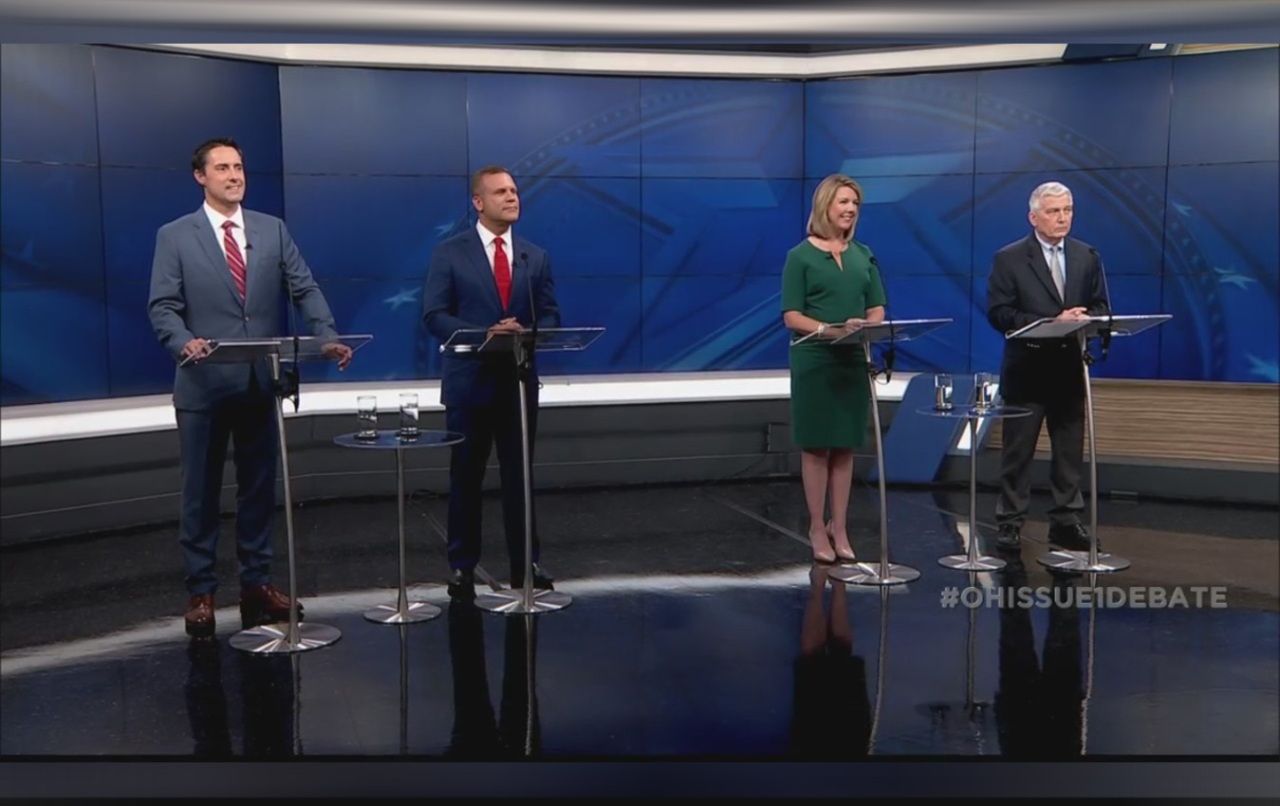Three takeaways from Ohio's Issue 1 debate
COLUMBUS, Ohio (WCMH) – Abortion, minimum wage, gender-affirming care and partisan gerrymandering were thrown across the debate stage Tuesday night, even if voters will decide on none of those things in two weeks.
State lawmakers and policy experts on both sides of Issue 1 debated the proposal at NBC4/WCMH-TV’s studio Tuesday night, calling undecided voters to action in the August special election. The issue would enact stricter requirements for citizen-proposed constitutional amendments to make it to voters’ ballots and become law.
Secretary of State Frank LaRose and Ohio Right to Life President Mike Gonidakis argued in support of the issue. House Minority Leader Allison Russo and former Columbus Dispatch editor and state lawmaker Mike Curtin argued against.
If passed, Issue 1 would require all future citizen-initiated amendments – as opposed to legislature-initiated amendments – to win at least 60% of the vote to pass instead of the simple majority currently needed.
To get an initiative on the ballot, groups would have to collect signatures from 5% of registered voters in all 88 Ohio counties, an increase from the current 44-county requirement. An existing 10-day curing period for groups who did not gather enough valid signatures would be eliminated.
Ohio voted in 1912 to establish the path for citizens to amend the constitution. Since then, voters have passed 20 citizen-initiated amendments, including raising the minimum wage, establishing casinos in certain cities and enshrining additional rights for crime victims.
What is the role of Ohio’s constitution? It depends who you ask.
To proponents of Issue 1, the state constitution is Ohio’s most sacred governing document – and to treat it as such means to strengthen the protections surrounding it. It is not a policy document, LaRose said, and any changes should come from with overwhelming support from voters, instead of a simple majority.
“If you can’t get a broad, bipartisan, north-south-east-and-west kind of consensus together, then leave our constitution alone,” LaRose said.
Both LaRose and Gonidakis pointed to citizens’ other direct initiative path, the initiated statute, as the appropriate avenue for citizens’ policy aspirations. Initiated statutes, which change the Ohio Revised Code, are not impacted by Issue 1 and require a simple majority of voters to pass.
LaRose referred to the federal constitution, which requires the approval of three-quarters of states to amend, as an example of the importance of maintaining stability in Ohio’s foundational text.
Issue 1’s opponents – none more publicly than Curtin – have a fundamentally different conception of the state constitution.
“Anybody who tries to compare any state constitution to the U.S. constitution flunks Federalism 101, flunks Constitutionalism 101,” Curtin said.
Curtin hearkened to James Madison, who wrote in the Federalist Papers that the U.S. Constitution’s powers will be “few and defined,” while powers reserved for state constitutions will be “numerous and indefinite.”
“Why?” Curtin asked. “Because the founders intended to leave all the details to the states and the state constitutions.”
Abortion takes center stage
In the shadow of Issue 1 is the November election, when Ohio voters will decide whether to enshrine abortion rights in the state constitution. Both supporters and opponents of Issue 1, including the panelists, have linked the issue to abortion rights, albeit in different ways.
Gonidakis and LaRose repeatedly asserted that Issue 1 defends the state constitution from extremist policies crafted by out-of-state special interest groups – none more immediately threatening than a proposal to protect abortion rights up to the point of fetal viability, or about 23 weeks.
LaRose previously told voters that Issue 1 is “100% about abortion” and other topics possible topics of future amendments, including gun control and minimum wage.
“[The abortion amendment] absolutely takes away parental consent, if they’re successful – which they won’t be in November. That’s how dangerous it is,” Gonidakis said. “It absolutely allows for a late-term abortion up to the ninth month in pregnancy.”
The proposed abortion amendment, which can be read here, makes no mention of parental consent or minors receiving abortion care. A pro-Issue 1 ad, which asserted the same claim as Gonidakis, has been disproven by constitutional law experts.
Both Gonidakis and LaRose defended that ad Tuesday night, with LaRose saying it serves as a cautionary tale to voters.
“The list of bad things coming our way if we don’t all vote yes on Issue 1 is pretty long, and that ad just goes through a few of them,” LaRose said.
Russo pointed to the abortion rights amendment – which was officially cleared to appear on voters’ ballots Tuesday afternoon – as evidence of the importance of maintaining a path for citizens to circumvent a legislature unresponsive to its citizens.
She cited the most recent polling – a Suffolk University/USA Today poll that found that about 58% of Ohio voters support the abortion amendment – as evidence that the decidedly anti-abortion Republican supermajority in the legislature is unreflective of Ohioans.
“When you look at the extreme policies being passed in the statehouse, and where Ohioans really are on some of these issues, [Republican legislators] are vastly out of step,” Russo said. “Ohio has this right, that when [the legislature is] that out of step or they are corrupt, they can go to the ballot box and demand changes.”
What panelists could agree on
For all their sparring, both supporters and opponents of Issue 1 agreed that the special election on Aug. 8 is a high-stakes one – one with significant implications for Ohio’s future.
According to Gonidakis, if Issue 1 doesn’t pass, Ohio will be flooded with cash from out-of-state billionaires with ulterior motives.
LaRose reiterated the veracity of that threat in his closing statement, again asserting that Issue 1 is the surest way to protect Ohio’s constitution.
“The other side doesn’t trust the voters, and they want to try to ram through a radical agenda with the bare majority of 51 or 52%,” LaRose said. “Again, if you got 51 or 52% that like your idea, then change the law, work with the legislature, do an initiated statute.”
To Russo, Issue 1 will dilute citizens’ power to directly influence their government. Requiring 60% of the vote amounts to the enactment of minority rule, she said, and the issue’s onerous signature requirements make it all but impossible for most proposals to make it to the ballot.
That’s by design, she said.
“They think you are too stupid to see that Issue 1 actually only protects corrupt politicians and special interests while hurting voters, but I know that you see right through this scheme,” Russo said.
Curtin looks no further than the history of the citizen-initiated amendment itself as evidence of its importance. More than 110 years ago, the push for a citizen initiative pathway came after a corruption-laden legislature became unresponsive to its constituents.
“If we don’t learn from history, we pay dearly from it,” Curtin said.
Source: NBC4 WCMH-TV


